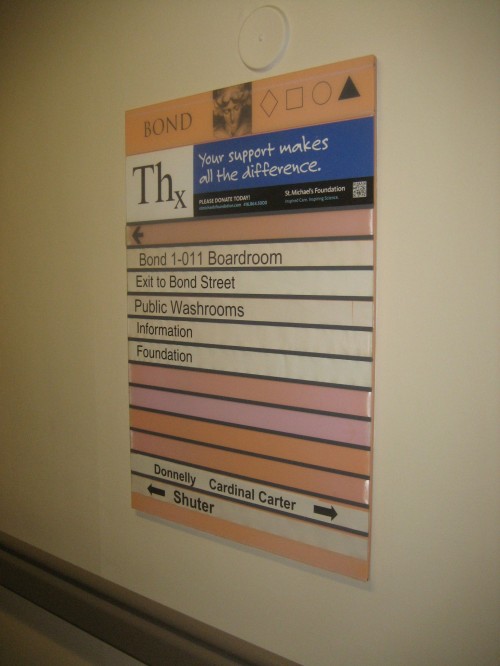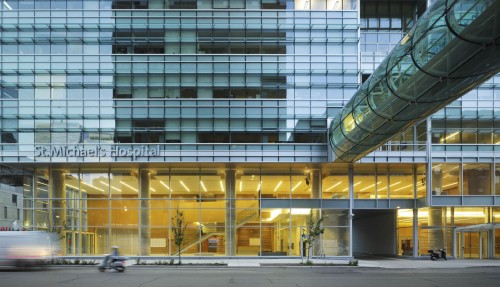By Peter Saunders
St. Michael’s Hospital in downtown Toronto has been in expansion mode over the past few years, opening a new wing and adding an entirely new building, which has meant a need for new signage, including wayfinding and donor recognition systems. As these elements have been added, they have created something of a template for further expansions to come.
The Donnelly Wing, for example, represents the rebranding of the hospital’s former Queen Wing (named after the adjacent Queen Street) following a donation by philanthropist Terrence Donnelly, which provided the opportunity to develop a new style guide for wayfinding signs.
The Li Ka Shing Knowledge Institute, meanwhile, is designed to bring clinicians, educators and researchers together to develop best practices and accelerate the delivery of new services to patients. Initially conceptualized as a research centre, but then growing to a massive scale, it required a new, centralized strategy for donor recognition.
In both cases, the sign manufacturer’s role was more like that of a strategic consultant than an off-site supplier.
“Dialogue with both architects and clients has become part of the process of producing and rolling out signage,” says Keith Francis, vice-president (VP) of strategic planning and business development for Acumen Visual Group in Markham, Ont., which has worked with the hospital on these and other projects. “It used to be the case that sign fabricators were not part of those discussions, but now we are involved earlier on in the process to translate two-dimensional (2-D) drawings into three-dimensional (3-D) reality. With St. Michael’s, our voice was heard and design mandates were changed.”

The older signs were designed to be updated periodically with printed inserts, but some were never refreshed and others inconsistently.
A history of growth
St. Michael’s Hospital was founded in 1892 by the Sisters of St. Joseph. As a teaching and research hospital serving the inner city, it established Canada’s first Catholic nursing school. When it opened, the facility had 26 beds, six doctors and four graduate nurses.
By 1912, St. Michael’s had grown to encompass 300 beds across two large wards, one of Toronto’s first X-ray machines, an emergency department, a five-room operating suite and a nursing school. A formal agreement to receive students from the University of Toronto’s (U of T’s) faculty of medicine was negotiated in 1920 and continues today.
The hospital now serves as downtown Toronto’s adult trauma centre and one of Ontario’s major care facilities for critically ill patients. With 467 acute adult inpatient beds, 720 physicians, 1,760 nurses, 5,741 staff members and 538 volunteers spread across nearly two million square feet of property, it has become a hub for complex cardiac and cardiovascular care, minimally invasive surgery, diabetes and osteoporosis care, neurosurgery and care for the homeless and disadvantaged.
Donnelly Wing
When the Queen Wing—the largest of the hospital’s four wings—was renamed after Terrence Donnelly, new wayfinding signage was needed throughout.
The existing signs had been installed in 1998. They were designed to be updated periodically as needed with printed inserts, but the hospital had not dedicated any staff to this task over the years. As such, some signs had never been refreshed, while others were updated inconsistently, e.g. indicating ‘X-ray’, ‘scanning’ and ‘imaging,’ which all referred to the same department.






